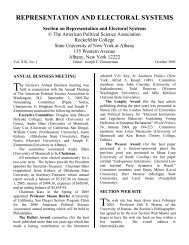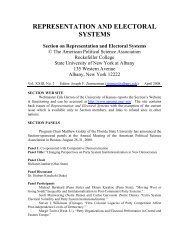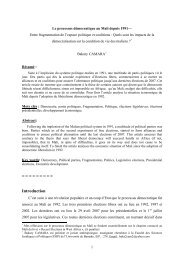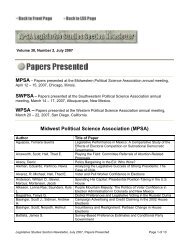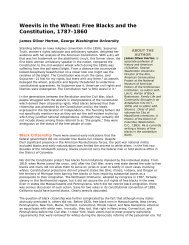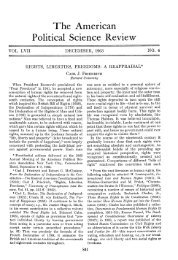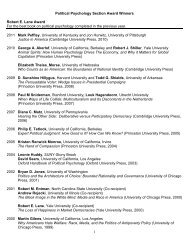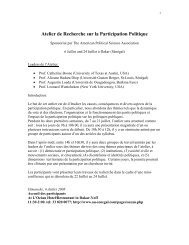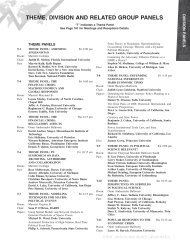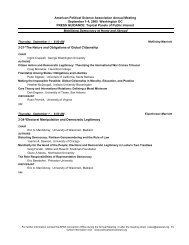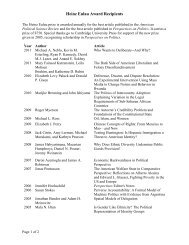representation and electoral systems - American Political Science ...
representation and electoral systems - American Political Science ...
representation and electoral systems - American Political Science ...
You also want an ePaper? Increase the reach of your titles
YUMPU automatically turns print PDFs into web optimized ePapers that Google loves.
14<br />
BOOK REVIEWS<br />
Richard Vergroff, Editor<br />
Kennesaw State University<br />
E-Mail: rvergrof@kennesaw.edu<br />
Section members with forthcoming books should notify the book editor to<br />
facilitate the speedy review of their books.<br />
Anne Tiernan. Power Without Responsibility. Coogee, NSW: University of New South<br />
Wales Press, 2007. AUS$34.95.<br />
This volume updates James Water’s book entitled The Minister’s Minders:<br />
Personal Advisers in National Government (Melbourne: Oxford University Press, 1986)<br />
<strong>and</strong> documents the growing size <strong>and</strong> influence of ministerial staff <strong>and</strong> the reduced role of<br />
career civil servants, especially departmental secretaries, during the previous three<br />
decades. Her study raises fundamental questions of democratic accountability in the<br />
Australian parliamentary system that is modeled on the traditional Westminster system.<br />
This system is based upon the Government (Cabinet) being responsible to<br />
parliament whose members are responsible to <strong>and</strong> elected by voters. Under this system,<br />
the department secretary was the principal adviser to a minister with a departmental<br />
portfolio. The book documents the fact the system has been modified <strong>and</strong> “secretaries<br />
must share the advisory space with the new legions of ministerial staff” (p. 3). This staff<br />
is larger than counterpart staffs in Canada <strong>and</strong> the United Kingdom <strong>and</strong> led the author to<br />
draw a conclusion in Chapter 1: “There is thus growing awareness that personal staff are<br />
an awkward fit in Westminster-style <strong>systems</strong>.” (p. 13).<br />
Chapters 2 <strong>and</strong> 3 present an overview of the growth of ministerial staffing<br />
concomitant with a more presidential media style. Ministers <strong>and</strong> their staff work in their<br />
parliamentary offices <strong>and</strong> thus are isolated from the staff of their respective portfolio<br />
department. The 1973 parliamentary election produced a Labor Government distrustful of<br />
civil servants <strong>and</strong> an exp<strong>and</strong>ed ministerial staff to ensure ministers would control policy<br />
making <strong>and</strong> implementation. The report of the Royal Commission on Australian<br />
Government <strong>and</strong> Administration is noted.<br />
Tiernan in chapter 4 traces ministerial staffing under Prime Ministers Whitlam,<br />
Hawkes, Keating, <strong>and</strong> Fraser in the period ending in 1996 <strong>and</strong> refers to a 1984<br />
amendment of the Public Service Act relating to civil servants seconded to ministerial<br />
offices <strong>and</strong> their roles, including policy advice <strong>and</strong> their accountability. The amendment<br />
also provides for the rotation of departmental secretaries every five years <strong>and</strong> in 1993<br />
term limits for secretaries were established.<br />
Chapter 5 focuses upon the agenda of Prime Minister John Howard who became<br />
leader of the Library Party in January 1995 <strong>and</strong> led the party to victory in the 1996<br />
general election. The new coalition Government had been in opposition for thirteen years<br />
<strong>and</strong> was suspicious of civil servants. Howard terminated the contracts of six<br />
departmental secretaries <strong>and</strong> appointed a political figure as cabinet secretary, a post<br />
historically held by a civil servant. Howard continued to reside in Sydney instead of<br />
Canberra which gave his Government “independence from the Canberra m<strong>and</strong>arins” (p.<br />
89). Although the staff for the twenty-eight Ministers initially was reduced from 364 to



